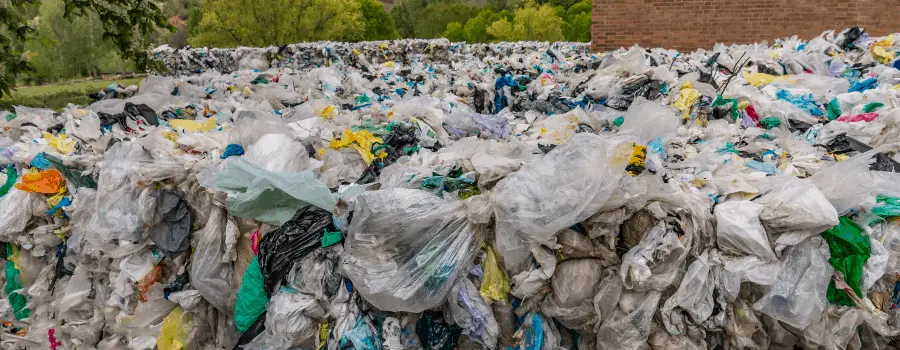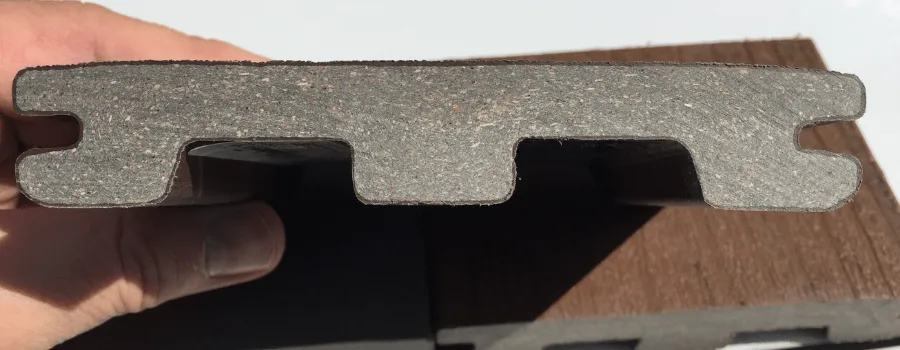One of the biggest advantages of composite decking is years of low maintenance. But after all those years of enjoyment, when the decking started to fade and break down. When you finally need to replace the old composite decking. What do you do with the old or off cuts of composite decking? Is the landfill the only place for composite decking, or can it be recycled?
Composite decking with its combination of high-density polyethylene (HDPE) and organic fibres, like wood or bamboo bonded together with chemical bonding agents, have limited recycling potential. Making composite decking currently un-recyclable on a large scale.
This is one of the most disappointing aspects of composite decking. That the price of years of low maintenance decking is a material that cannot be readily recycled. The very characteristic of good composite decking , its tight bonding together of materials makes it un-recyclable.
, its tight bonding together of materials makes it un-recyclable.
None of us want decking that breaks apart on our deck, requiring constant replacement and upkeep. That’s why composite is so popular for decks. A durable decking that will not break down in the harsh outdoor environment.
There are many composite decking brands. Click the link to see some of the best composite decking brands  on the market.
on the market.
There is some hope regarding recycling of composite decking , but currently, little can be done with composite decking after use except to bury it in the landfill. Which unfortunately, unlike pressure-treated decking, which will decompose, composite decking will not. Composite decking will sit in the ground
, but currently, little can be done with composite decking after use except to bury it in the landfill. Which unfortunately, unlike pressure-treated decking, which will decompose, composite decking will not. Composite decking will sit in the ground for centuries or longer. We have no real way of knowing. Composite decking is a new product with limited knowledge of how and what time it takes to break down.
for centuries or longer. We have no real way of knowing. Composite decking is a new product with limited knowledge of how and what time it takes to break down.
What we do know is recycling works best and is easiest with homogeneous material. This is why glass and metal have been recycled for years. Long before its environmental benefits but its simple single material structure, it could be easily and readily melted and reused.
Composite Decking From Recycling
Composite decking is not so easily recycled because it’s a combination of two very different materials. How we process and use the end of life material depends greatly on the material. The plastics which composite decking is composed of, is oil-based. Which technology and industry have evolved to recycle. In fact, that is one of the driving reasons behind composite decking, recycling.
“We are a recycling company that manufactures decking”
MoistureShield
MoistureShield is not an anomaly among composite decking manufactures. Recycling plays a huge role in the manufacturing of composite decking. It is hard to find a composite decking on the market that does not consist of recycled material. Varying by companies, but recycling is an integrated part of the industry.
is not an anomaly among composite decking manufactures. Recycling plays a huge role in the manufacturing of composite decking. It is hard to find a composite decking on the market that does not consist of recycled material. Varying by companies, but recycling is an integrated part of the industry.
One of the leaders in using recycled material is Trex.
“We make Trex® eco-friendly composite decks from an innovative blend of 95% reclaimed wood and plastic film—that’s almost the whole thing.”
Trex
Even on the lower end of material recycling, TimberTech still makes their composite decking with 80% recycled material.
still makes their composite decking with 80% recycled material.
That’s a lot of waste being diverted away from landfills through recycling into composite decking. Trex claims over 500 million pounds of plastic film and wood yearly. TimberTech is not far behind, with 290 million pounds of waste and scrap materials used for decking instead of being buried in landfills.

On average, a 500 square foot Trex composite deck contains 140 000 recycled bags, films and wraps. It almost makes you want to build a deck just to help empty the landfills.
Not only is waste diverted away from landfills with composite decking, but it also reduces energy consumption. Stanford University has found that recycling one ton of plastic saves.
has found that recycling one ton of plastic saves.
- 5 774 Kwh of energy
- 16.3 barrels of oil
- 98 million Btu’s of energy
- 30 cubic yards of landfill space
Trex is made out of more than just plastic bags, originally milk cartons and similar material have initially been, and I imagine they are still part of the mix. But if it was strictly bags, 140 000 bags being recycled for a 500 square foot Trex composite deck . The recycling savings are roughly.
. The recycling savings are roughly.
- 4 965 Kwh of energy
- 14 barrels of oil
- 84 million Btu’s of energy
- Freeing up 25.8 cubic yards of landfill
That is a huge net positive in reducing energy consumption from composite decking.
End-Use, Problems with Recycling Composite Decking
Or at least in the creation of composite decking. We still have the problem of end-use or recycling of composite decking.
“When you mix an industrial material (plastic) that is recyclable with a biological materials (wood) that is compostable you get a material that is neither recyclable nor compostable.”
Treehugger
Which is the greatest challenge with recycling composite decking. One component is recyclable, but the other is better composted. The binding agent required to make high quality low maintenance decking prevents the separation of the two. Unlike aluminum tins with paper labels, which can be easily removed for recycling, composite cannot be separated. Limiting what can be done with old composite decking.
The further challenge is the durability of the material. Plastic has a much longer durability than wood. This was one of the original challenges and why capped decking is so prevalent today. Organic material, the wood fibres will decompose sooner than the plastic. Meaning exposed wood fibres on the surface of the product will rot.

Severely limiting the potential of recycling composite decking. You cannot reclaim the material together, and you cannot separate the material to be recycled.
Grinding or shredding composite decking, a common first step in recycling material, exposes the organic material. Which becomes a weakness in whatever new product you are making out of the recycled composite.
Limiting old composite decking to a filler material. Which there has been some limited success in doing. Recycling composite into items like tool trays, shutters or rot-resistant shims. Products which the shredding composite decking can be press and formed into and then covered with another material for protection and appearance.
But as a recycled filler material, composite currently has limited use.
A little of chicken and egg situation.

We need large amounts of composite decking feedstock that are economically available for industry to create innovative products that can use it. But without current demand, there is no value in gathering large quantities of old composite decking to be ground for recycling.
Recycling of composite won’t happen if there is no demand. Without demand, composite filler will not be economically available.
Compounding the problem of recycling composite decking is limited amounts of old decking to recycle. Which is a good thing. Composite decking was created to last a long time, decreasing the quantity of decking needing to be recycled annually.
As a deck contractor, I only replace the occasional composite deck. Maybe one every couple of years or so. Meaning I have no idea where to haul the old decking to be recycled. Let alone. No business will survive collecting composite decking to be recycled if only a few decks a year are being disposed of in the city.
Possibly, with the increased number of composite decks being built today. It is possible 25 to 30 years from now. When many more are being replaced that the infrastructure and know-how will be developed by then.
I am old enough to remember when only pop cans and bottles were recycled. This morning the recycling truck drove by and pick up all my households recycling to be sorted and hopefully sent to recycling. There have been some hick-ups. In 2019 Calgary was forced to send tonnes of material sorted for recycling to landfills for lack of facilities and demand for the material.
was forced to send tonnes of material sorted for recycling to landfills for lack of facilities and demand for the material.
But I am still optimistic that one day, when the composite decks I build today. Have given many decades of enjoyment that they can and will be recycled. Not yet. Currently, composite decking is only recycled in limited quantity. Most end up in the landfill.
Limited recycling used as a filler material, which to, in time, will head to the landfill.
Maybe that is the best that composite decking can do. Delay the inevitable, rather than milk jugs, plastic bags and sawdust being sent to the landfill today. They can be enjoyed for many years, as decks in our yards, before finally heading to their final resting place.
Additional Ways to Recycle and Use Composite Decking Off Cuts
Not as valuable for old composite decking needing to be replaced. There is a reason you are replacing the old, fade and breaking composite decking .
.
But there are some uses for new composite decking offcuts that can create value before heading to the landfill. Reducing waste of this valuable and amazing material.
I am not a master at this, but here are a few sites to get some ideas. Ways to use composite decking offcuts rather than throwing them out.
Family Handy Man has a list of 10 composite decking projects with pictures.
has a list of 10 composite decking projects with pictures.
The DIY Nuts , I didn’t choose their name. Has a very detailed step by step instructions for recycling composite decking offcuts into a table.
, I didn’t choose their name. Has a very detailed step by step instructions for recycling composite decking offcuts into a table.
Not to be left out but many composite decking manufactures also have ideas of how to use and recycled composite decking offcuts.
Deckorators has a list of seven. Honestly not as helpful with many pictures being of wood products you could build out of composite decking instead. Simply put, is there a project that you could cut and shape out of composite pieces instead of wood. The workability of both is very similar. Which is one reason, as a carpenter, I enjoy building composite decks. They build very similar to wood.
has a list of seven. Honestly not as helpful with many pictures being of wood products you could build out of composite decking instead. Simply put, is there a project that you could cut and shape out of composite pieces instead of wood. The workability of both is very similar. Which is one reason, as a carpenter, I enjoy building composite decks. They build very similar to wood.
TimberTech calls it upcycling, showing ways that you can use composite decking offcuts instead of through them away. Not the most helpful solution, but it is a very durable product with an amazing finish. It could be used for much more than a paperweight. But hey, that’s one use.
calls it upcycling, showing ways that you can use composite decking offcuts instead of through them away. Not the most helpful solution, but it is a very durable product with an amazing finish. It could be used for much more than a paperweight. But hey, that’s one use.
